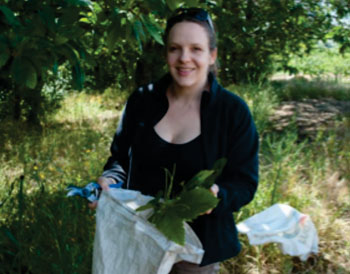Plant Extract Prevents Bacterial Skin Infections by Disrupting Quorum Sensing
By LabMedica International staff writers
Posted on 31 Aug 2015
An extract prepared from the leaves of the European chestnut Castanea sativa, a stalwart of Mediterranean region folk medicine, has been found to efficiently block the virulent effects of Staphylococcus aureus by preventing toxin production rather than by killing the organism.Posted on 31 Aug 2015
Research on medical folklore in several Mediterranean countries led investigators from Emory University (Atlanta, GA, USA) to the European chestnut. Extracts from the leaves of this plant had long been used by locals to wash their skin as a treatment for skin infections and inflammations.

Image: Research headed by Emory University ethnobotanist Dr. Cassandra Quave, shown collecting chestnut leaves in Italy, was inspired by traditional folk remedies (Photo courtesy of Marco Caputo).
In the laboratory, the investigators evaluated the extract for ability to block Staphylococcus aureus infection and ultimately identified more than 94 compounds. One fraction, enriched with derivatives of the triterpenes ursene and oleanene, was found to be particularly effective in preventing S. aureus infection while not actually killing the bacteria.
The investigators found that this fraction actually blocked the organism's quorum sensing inhibitory activity. Quorum sensing is a mechanism used by pathogenic bacteria not only to modulate virulence factor production but also to adapt to the metabolic demands of living in communities. Quorum-sensing systems have been shown to be key virulence regulators in both gram-negative and gram-positive pathogens. It has been suggested that quorum sensing represents a novel target for the development of agents to treat or prevent bacterial infections.
Results published in the August 21, 2015, online edition of the journal PLOS ONE presented evidence of the extract's Staphylococcus aureus accessory gene regulator (agr) allele blocking activity, as measured in toxin outputs, reporter assays hemolytic activity, cytotoxicity studies, and an in vivo abscess model. The results demonstrated the extract’s lack of cytotoxicity to human keratinocytes and murine skin, as well as lack of growth inhibitory activity against S. aureus and a panel of skin commensals. In addition, they showed that serial growth of the bacteria in the presence of the extract did not result in acquisition of resistance to the quorum quenching effect.
"We were able to trace out the pathways in the lab, showing how our botanical extract blocks quorum sensing and turns off toxin production entirely," said first author Dr. Cassandra Quave, assistant professor of biology at Emory University. "Many pharmaceutical companies are working on the development of monoclonal antibodies that target just one toxin. This is more exciting because we have shown that with this extract, we can turn off an entire cascade responsible for producing a variety of different toxins."
"We have identified a family of compounds from this plant that have an interesting medicinal mechanism," said Dr. Quave. "Rather than killing staph, this botanical extract works by taking away staph's weapons, essentially shutting off the ability of the bacteria to create toxins that cause tissue damage. In other words, it takes the teeth out of the bacteria's bite. It is easy to dismiss traditional remedies as old wives' tales, just because they do not attack and kill pathogens, but there are many more ways to help cure infections, and we need to focus on them in the era of drug-resistant bacteria."
Related Links:
Emory University














